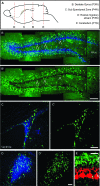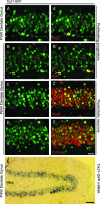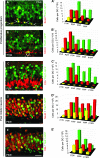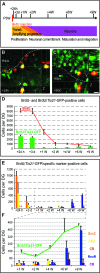Tis21 expression marks not only populations of neurogenic precursor cells but also new postmitotic neurons in adult hippocampal neurogenesis
- PMID: 19482889
- PMCID: PMC2803732
- DOI: 10.1093/cercor/bhp100
Tis21 expression marks not only populations of neurogenic precursor cells but also new postmitotic neurons in adult hippocampal neurogenesis
Abstract
During embryonic cortical development, expression of Tis21 is associated with cell cycle lengthening and neurogenic divisions of progenitor cells. We here investigated if the expression pattern of Tis21 also correlates with the generation of new neurons in the adult hippocampus. We used Tis21 knock-in mice expressing green fluorescent protein (GFP) and studied Tis21-GFP expression together with markers of adult hippocampal neurogenesis in newly generated cells. We found that Tis21-GFP 1) was absent from the radial glia-like putative stem cells (type-1 cells), 2) first appeared in transient amplifying progenitor cells (type-2 and 3 cells), 3) did not colocalize with markers of early postmitotic maturation stage, 4) was expressed again in maturing neurons, and 5) finally decreased in mature granule cells. Our data show that, in the course of adult neurogenesis, Tis21 is expressed in a phase additional to the one of the embryonic neurogenesis. This additional phase of expression might be associated with a new and different function of Tis21 than during embryonic brain development, where no Tis21 is expressed in mature neurons. We hypothesize that this function is related to the final functional integration of the newborn neurons. Tis21 can thus serve as new marker for key stages of adult neurogenesis.
Figures






Similar articles
-
Impaired terminal differentiation of hippocampal granule neurons and defective contextual memory in PC3/Tis21 knockout mice.PLoS One. 2009 Dec 17;4(12):e8339. doi: 10.1371/journal.pone.0008339. PLoS One. 2009. PMID: 20020054 Free PMC article.
-
Brain Insulin-Like Growth Factor-I Directs the Transition from Stem Cells to Mature Neurons During Postnatal/Adult Hippocampal Neurogenesis.Stem Cells. 2016 Aug;34(8):2194-209. doi: 10.1002/stem.2397. Epub 2016 May 27. Stem Cells. 2016. PMID: 27144663
-
Differential 24 h responsiveness of Prox1-expressing precursor cells in adult hippocampal neurogenesis to physical activity, environmental enrichment, and kainic acid-induced seizures.Neuroscience. 2008 Jun 23;154(2):521-9. doi: 10.1016/j.neuroscience.2008.04.023. Epub 2008 Apr 22. Neuroscience. 2008. PMID: 18502050
-
Control of the Normal and Pathological Development of Neural Stem and Progenitor Cells by the PC3/Tis21/Btg2 and Btg1 Genes.J Cell Physiol. 2015 Dec;230(12):2881-90. doi: 10.1002/jcp.25038. J Cell Physiol. 2015. PMID: 25967096 Review.
-
Milestones of neuronal development in the adult hippocampus.Trends Neurosci. 2004 Aug;27(8):447-52. doi: 10.1016/j.tins.2004.05.013. Trends Neurosci. 2004. PMID: 15271491 Review.
Cited by
-
Transcriptome sequencing during mouse brain development identifies long non-coding RNAs functionally involved in neurogenic commitment.EMBO J. 2013 Dec 11;32(24):3145-60. doi: 10.1038/emboj.2013.245. Epub 2013 Nov 15. EMBO J. 2013. PMID: 24240175 Free PMC article.
-
Role of neuronal ras activity in adult hippocampal neurogenesis and cognition.Front Neurosci. 2011 Feb 14;5:18. doi: 10.3389/fnins.2011.00018. eCollection 2011. Front Neurosci. 2011. PMID: 21427796 Free PMC article.
-
Btg1 is Required to Maintain the Pool of Stem and Progenitor Cells of the Dentate Gyrus and Subventricular Zone.Front Neurosci. 2012 Aug 30;6:124. doi: 10.3389/fnins.2012.00124. eCollection 2012. Front Neurosci. 2012. PMID: 22969701 Free PMC article.
-
Hilar granule cells of the mouse dentate gyrus: effects of age, septotemporal location, strain, and selective deletion of the proapoptotic gene BAX.Brain Struct Funct. 2017 Sep;222(7):3147-3161. doi: 10.1007/s00429-017-1391-5. Epub 2017 Mar 17. Brain Struct Funct. 2017. PMID: 28314928 Free PMC article.
-
Noise induced hearing loss impairs spatial learning/memory and hippocampal neurogenesis in mice.Sci Rep. 2016 Feb 4;6:20374. doi: 10.1038/srep20374. Sci Rep. 2016. PMID: 26842803 Free PMC article.
References
-
- Altman J, Bayer SA. Migration and distribution of two populations of hippocampal granule cell precursors during the perinatal and postnatal periods. J Comp Neurol. 1990a;301:365–381. - PubMed
-
- Altman J, Bayer SA. Vertical compartmentation and cellular transformations in the germinal matrices of the embryonic rat cerebral cortex. Exp Neurol. 1990b;107:23–35. - PubMed
-
- Brandt MD, Jessberger S, Steiner B, Kronenberg G, Reuter K, Bick-Sander A, von der Behrens W, Kempermann G. Transient calretinin expression defines early postmitotic step of neuronal differentiation in adult hippocampal neurogenesis of mice. Mol Cell Neurosci. 2003;24:603–613. - PubMed
Publication types
MeSH terms
Substances
LinkOut - more resources
Full Text Sources
Medical

